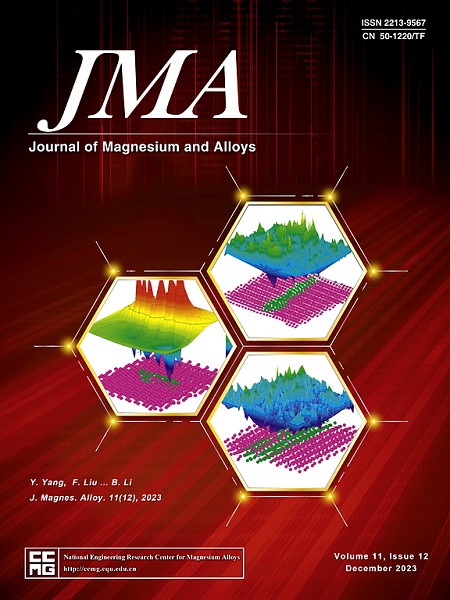AZ31镁合金线弧增材制造效率-组织-性能协同优化
IF 13.8
1区 材料科学
Q1 METALLURGY & METALLURGICAL ENGINEERING
引用次数: 0
摘要
在电弧丝增材制造(WAAM)中,在沉积效率、微观结构和机械性能之间存在权衡。针对这一挑战,本文提出了一种针对AZ31镁合金部件WAAM的创新多目标优化框架,该框架将沉积效率和微观结构作为耦合目标,并通过NSGA-II算法进行求解。该框架采用二次回归方法,通过几何形态中介将工艺参数与沉积效率关联起来,同时通过将理论见解与数据驱动的堆叠集成学习相结合,解决WAAM中的不确定性,用于粒度预测,建立混合物理信息数据方法,用于WAAM微观结构预测。优化后的工艺沉积速率为6257 mm³/min,有效宽度和平均层高分别保持在10.1 mm和4.13 mm。优化后的晶粒结构为均匀细小、完全等轴的晶粒,平均晶粒尺寸为38 μm。这些发现强调了WAAM智能优化策略在航空航天和运输领域制造轻质、高性能部件方面的巨大工业潜力。本文章由计算机程序翻译,如有差异,请以英文原文为准。

Synergistic optimization of efficiency-microstructure-performance in wire-arc additive manufacturing of AZ31 magnesium alloy
In wire arc additive manufacturing (WAAM), a trade-off exists among deposition efficiency, microstructure, and mechanical properties. Addressing this challenge, this work proposes an innovative multi-objective optimization framework tailored for WAAM of AZ31 magnesium alloy components, which integrates deposition efficiency and microstructure as coupled objectives and is resolved through the NSGA-II algorithm. The proposed framework employs quadratic regression to correlate process parameters with deposition efficiency through geometric morphology mediation, while addressing uncertainties in WAAM by integrating theoretical insights with data-driven stacked ensemble learning for grain size prediction, establishing the hybrid physics-informed data method for WAAM microstructure prediction. The optimized process achieved a deposition rate of 6257 mm³/min, with effective width and average layer height maintained at 10.1 mm and 4.13 mm, respectively. Microstructural optimization produced a fine, uniform, fully equiaxed grain structure with an average grain size of 38 μm. These findings underscore the significant industrial potential of intelligent optimization strategies in WAAM for manufacturing lightweight, high-performance components in aerospace and transportation sectors.
求助全文
通过发布文献求助,成功后即可免费获取论文全文。
去求助
来源期刊

Journal of Magnesium and Alloys
Engineering-Mechanics of Materials
CiteScore
20.20
自引率
14.80%
发文量
52
审稿时长
59 days
期刊介绍:
The Journal of Magnesium and Alloys serves as a global platform for both theoretical and experimental studies in magnesium science and engineering. It welcomes submissions investigating various scientific and engineering factors impacting the metallurgy, processing, microstructure, properties, and applications of magnesium and alloys. The journal covers all aspects of magnesium and alloy research, including raw materials, alloy casting, extrusion and deformation, corrosion and surface treatment, joining and machining, simulation and modeling, microstructure evolution and mechanical properties, new alloy development, magnesium-based composites, bio-materials and energy materials, applications, and recycling.
 求助内容:
求助内容: 应助结果提醒方式:
应助结果提醒方式:


